By Rob Krott
In the April 2001 (Vol. 4 No. 7) issue of Small Arms Review we ran an article by Rob Krott, our Military Affairs Correspondent titled “Into the Khyber”. It was about a recent trip he made to the Pakistan / Afghanistan area detailing his visit and his experiences with the local people and customs he encountered. Given the recent events of 09-11-01, we asked Rob to submit an additional article with some insight into the guns and the local gun industry specifically and this is his follow up.
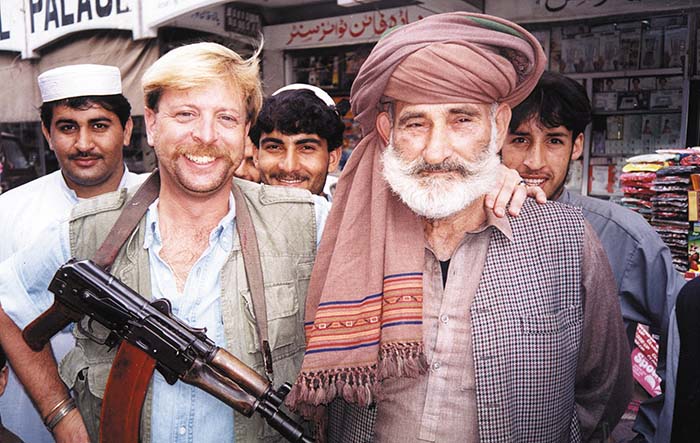
The narrow point of the Khyber Pass is at Ali Masjid. Above the Ali Masjid mosque sits the Ali Masjid fort, which overlooks the entire Khyber Pass. Here the road is one way as it’s only thirty meters or so wide. Before it was widened two camels could not walk abreast. To fully appreciate the Khyber Pass you must imagine trying to escape through the pass on foot while being shot at by Pathan snipers. Testifying to the near impossibility of such a feat, is a British cemetery full of graves from the Second Afghan War of 1879. The Khyber Pass walls bear the insignia of many British regiments, such as the Royal Sussex, the Gordon Highlanders, and the South Wales Borderers, to name but a few. Mute testimony to the far-flung reaches of a vanished empire, they reminded me of the arrogance of Daniel Dravot and Peachey Carnehan in Kipling’s The Man Who Would be King. At 1,200 meters in elevation, sitting at the end of the Khyber Pass railway and just eight kilometers from Afghanistan is Landi Kotal. Formerly “contraband city” full of hash and guns for sale and the plush homes of rich smugglers hidden behind compound walls, the smuggler’s trade has now moved to the Karkhanai Bazaar near Peshawar. After Landi Kotal the road forks: left to the Afghan border and right to Khyber Rifles headquarters. Bearing left it didn’t take long before we crested the last hill at Michni checkpoint to see the border post at Torkham. Beyond that lays Afghanistan. Unless you have a special pass and an Afghan visa this is the last stop — fifty-eight kilometers from Peshawar. The Michni guards are Khyber Rifles regulars armed with .308 Paki G-3s. These and our guard’s Kalashnikov were just about the only weapons I saw which weren’t locally made.
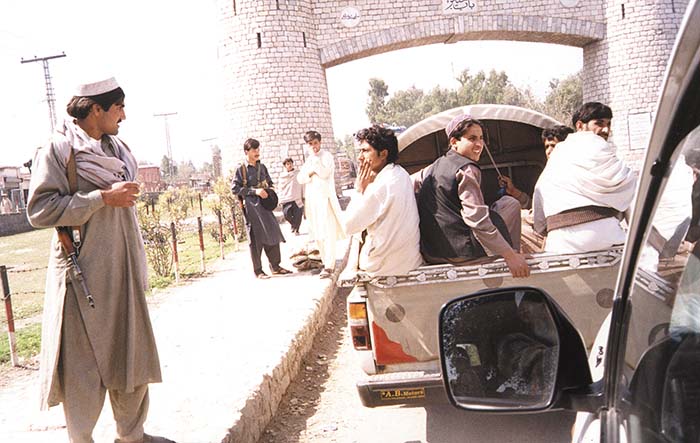
Cottage Industry
Situated about 25 miles south of Peshawar in the middle of the NWFP on the road to Kohat is Darra Adam Khel, a small village boasting about 100 gun shops and noted for its cottage firearms industry. Darra was responsible for equipping the bulk of the Mujahideen during the early days of the Soviet war in Afghanistan. Darra Adam Khel’s sole industry is weapons manufacturing. The town’s mom-and-pop gun shops house a cottage weapons industry unparalleled any where in the world. Darra produces about 20,000 firearms a year. With the average weapon selling for $100 that’s conservatively 2 million dollars a year being injected into this little village’s economy. Other than making guns or firing guns there’s not much else to do. Oh, yeah, there’s always hand loading the empty brass.
I went to the Home and Tribal Affairs office for a travel pass. An officious and obnoxious little Punjabi told me no. A discussion followed that finished with the comment: “It (Darra) is closed and I have no reason. If you decide to close one of your states to foreigners, you may do that (in your country).” Darra is frequently “officially” closed. Especially during the periods of heightened tribal and political unrest. The bureaucrats prohibit travel to Darra by foreigners, because of the very real possibility of kidnapping — a Pathan tribal specialty (ransom is 200,000 to 300,000 rupees or about $4,500 to $6,700). So travel to Darra is seldom authorized.
Here’s how unauthorized travel to Darra usually works: after finding and paying a guide/translator and a driver you proceed to Darra. At each police checkpoint you contribute to the local police officer’s personal pension fund. Surreptitiously slipping a wad of dirty rupees to the guide/translator who then mumbles a few entreaties in Pashto while presenting this baksheesh to the policeman, leaves you free to go. On the buses which service Darra the Pushtuns carrying weapons pay a set price to these same policemen. The size of the bribe is commensurate with the type of contraband weapon — say, 50 rupees for a pistol and 100 rupees for a Kalashnikov.
There has been less demand for weapons since the withdrawal of the Soviets, but the shops of Darra and others like them still do a good business supplying the various political factions, tribal groups, and, yes, criminals which occasionally make Pakistan (especially Sind and Punjab) a dangerous place to be. Inspector Pir Iqbal and sub-Inspector Adnan Orkzal of the Frontier Police in Peshawar told me there are over 7,000 Kalashnikovs in private hands in Karachi, the capital, where ethnic and political violence had broke out anew with nearly 300 people being killed in the past few months. Guns are also run into Kashmir, the new border flashpoint between Pakistan and India.
Nooristan Gun Factories
While not as well known as Darra there are also gun factories in Nooristan (not to be confused with the Nuristan across the border, but just as remote). In the village of Sakhakot near the famous Buddhist ruins at Takht-e-Bahi we picked our way along the muddy street as two mangy curs fought over some scrap. Small boys ran up to tug us toward some shops. A man wearing the traditional shalwar kameez, sandals, and a pakol – the flat, rolled pancake beret peculiar to Chitral, walked by with three rifles slung over his shoulder so we knew we were in the right place.
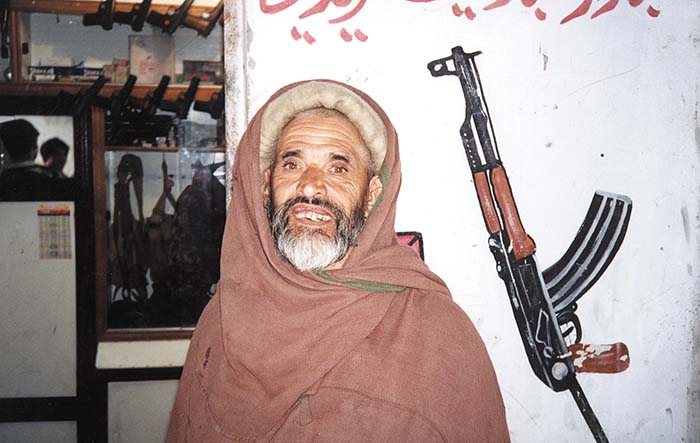
The gun shops of Sakhahot Malakand in the Azam Khan Market are small with the manufacturing sheds of mud-brick and tin located in the back alleys. Using standard patterns these artisans can crank out any of a dizzying array of firearms in a day on their small forges and meager collection of drill presses. A light machine gun completely made by hand would take a while, say ten days to two weeks. Also available are fragmentation grenades (do you want to trust these fuses?), anti-tank mines, small mortars, anti-aircraft guns, and heavy machine guns — mostly copies of the detritus left by the Soviet Union’s failed Afghan adventure. Weapons can also be made to order. Authentic Kalashnikovs can be had for as little as $300, but your made in Pakistan copy may be a better bargain. I mean, who wouldn’t want their very own “Special Rolex” Kalashnikov?
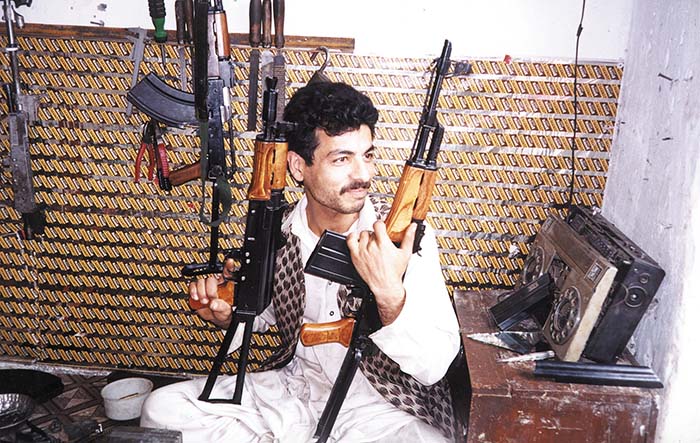
Weapons parts and loaned tools gripped in their greasy hands, small boys scurried to and fro. Schooling is considered unnecessary for an eight year old who can already file out a Tokarev frame in his father’s gun shop. One of the gun builders was smoking hash. I lit his joint for him with my Zippo and immediately wondered what the effect might be on the weapon’s tolerances. There was an interesting and eclectic collection of hybrid weaponry here: a British Sten gun chambered for 7.62 x 39mm and fitted with a Kalashnikov magazine. A very poor man’s AK, I guess. The idea of firing it made me a little nervous. I wouldn’t want to fire one of these, especially the ones chambered for rifle cartridges. Even without knowing the psi generated in the chamber, operating a submachine gun designed for a pistol cartridge with a muzzle velocity of 1280 fps versus the Kalashnikov round’s 2330 fps is not a smart bet.
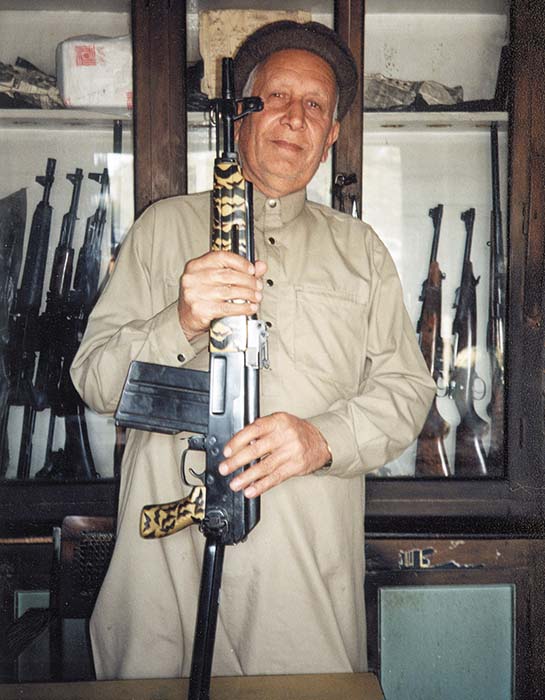
There were other variations on the Sten including double magazine equipped weapons in bizarre calibers such as .32 ACP or .30 caliber US carbine. Given the history of the area I wasn’t surprised to see so many copies of British military and sporting small arms including: Webley .32 and .38 caliber revolvers, more Webleys in any caliber imaginable, British Smith and Wesson .38 revolvers, Sten guns, and British .303 SMLEs (very popular especially with the older gentlemen who grew up with this weapon). Another good dependable bolt gun, the Mauser 98K, is also very common.
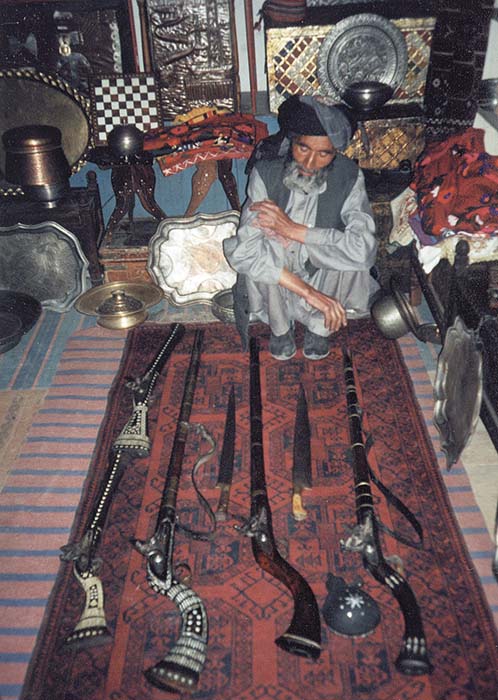
While the CETME rifle or G-3 is made under license in Pakistan these weapons are too complicated for the backyard machinists to fabricate. But the Pathan gun makers copy the G-3 magazine and barrel and use them with a Mauser bolt action in .308 / 7.62 NATO to make a weird hybrid complete with knurled pistol grip, military sights, and heavy straight stock with butt plate. There were bolt action AK-style hybrids including one 8mm Kalashnikov and various bolt guns with Kalashnikov actions or parts.
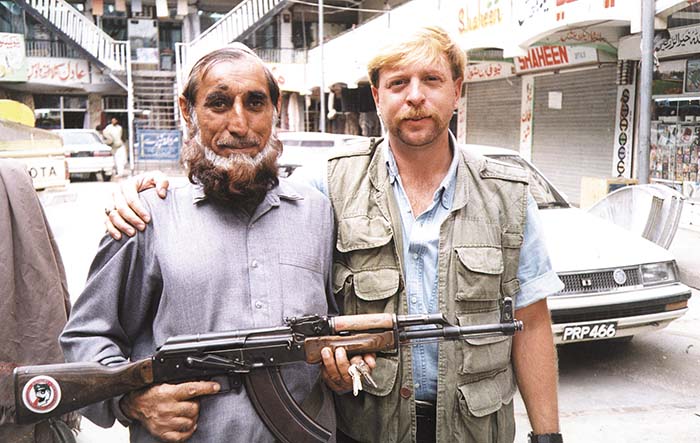
There were many Tokarevs in various calibers including .32 ACP as calibers larger than this are difficult to own in other parts of Pakistan, hence the popularity of this less than adequate caliber. I handled an interesting folding stocked semi-auto pistol incorporating Broomhandle Mauser and Tokarev design features which seemed to be a popular design in all the shops. I don’t know what to call it, but I want one.
Custom orders were not a problem. You name it and these guys build it … with varying degrees of effectiveness. I was told I could order an M79 Grenade Launcher or a 9mm Luger. While I did manage to send home a muzzle loading jezail from Kabul what I really wanted was a perfect copy of a 9mm Artillery Luger with snail-drum magazine and shoulder stock holster. While the workmanship appeared good (in many cases I couldn’t tell the difference from a factory piece without a detailed examination) the quality of the materials is still in doubt. Early on guns were made from old iron railroad rails and scrap metal. Now the steel is supposedly imported from Belgium, though I think several weapons were truck springs, construction rebar, or car frames in a previous life. Factor in unsophisticated forgings, castings from scrap, and parts filed from blanks of sub-standard steels and you’ve got to wonder if these weapons will hold up under the pressures generated by modern cartridges.
But the prices are certainly attractive: a Krinkov .222 made in Pakistan costs 4500 rupees (about $100 US). In comparison an original Soviet TT-33 Tokarev pistol captured in Afghanistan sells for 10,000 rupees ($220) while the “best copy” of a Tokarev costs 3,000 rupees. That’s $67 for a semi-auto pistol. According to Peer Alasha, a gun dealer “All Kinds of Arms and Ammunition Available Here” in Sakhahot, I’d just missed some excitement by about four hours. Early that morning the MCB bank just up the street was knocked off by six men with Kalashnikovs and robbed of 6 million rupees. Hmm. Wonder where they got the guns?
I wanted to test fire a couple of the more interesting weapons, but that wasn’t going to happen. They wouldn’t let me fire a locally made rifle: “Sometimes they blow up and the pieces could hit you in the head.” That answered my questions about quality assurance. Robert Pelton of The World’s Most Dangerous Places TV show wanted to video some weapons being fired so for a little product sampling we followed Ali Khan down a narrow alley between the gun shops and across a field to a promontory overlooking a river gorge. The weapons were a locally fabricated Tokarev and an authentic Chinese AKM (Type 59). I wasn’t too excited about the choice of weapons as I’ve fired a lot of Tokarevs and countless Kalashnikovs. I wasn’t too happy about the ammunition cost either: they wanted 800 rupees ($18) for a handful of rounds.. Pelton banged away with the Chinese Kalashnikov. Next was the pistol so I stepped up to pop a few caps. “It’s a very good copy,” I was told. Ejection was poor with every other round hanging up. Every time it jammed I would execute an immediate action drill. And every time it malfunctioned Ali would reach around to grab the weapon out of my hand. He nearly got a 7.62mm pistol round through his palm. On purpose. I finally gave him an elbow and told him to just let me shoot the damn thing.
The ammo was poor quality as well (which probably had a lot to do with the ejection problems) and I could discern differences in loads of the locally manufactured ammunition via the change in sound and recoil. While ammunition was a problem in the past (gun makers fabricated their own cartridges by reloading spent casings, using melted scrap for bullets, mixing their own powder, recasting old bullets, and re-priming old primers with match heads) you can now buy “factory” loads albeit still made in Pakistan. These rounds, as demonstrated with the Tokarev, are less than dependable.
Khyber Pass Guns
The next day, joined by “Baba,” a white-bearded bespectacled Pathan bearing a striking resemblance to Crumb’s “Keep on Truckin’” caricature, we went out to the gun bazaar just past the Khyber Pass do not enter sign for some more “shopping.” I inspected one of the notorious .22 caliber “Stinger” pen guns which crudely resembles a ballpoint pen. A favorite of tourists and also the Paki airport police and customs inspectors who know just what to look for on the X-ray machine at the Peshawar airport. There’s also the risk of being informed upon by the seller or any of the various hangers-on who seem to follow foreigners around. It is illegal for a foreigner to purchase a weapon. The dealers know this but are more than willing to sell you a piece anyway. Outside the tribal areas Pakistan has fairly strict gun laws governing the licensing and registration of rifles and pistols. Possession of an illegal firearm and use of a firearm in the commission of a crime carry harsh penalties.
The following day we went to Baba’s village, Regi, a series of walled compounds separated by narrow streets and alleys. Machine gun posts and gun ports on cornices provide interlocking fields of fire with their neighbors, usually related by blood or marriage. The Pushtuns are famous for kidnapping, yet I could travel unmolested into some of these border villages and have tea in the family compounds under protection of malmastia, one of the tenets of Pukhtunwali.
Entering the compound of some of Baba’s kinsmen we had some tea and I met a dizzying array of cousins. Finally we all piled into some Toyotas and drove out to a nearby riverbed for some shooting. The targets were Pepsi cans set up at the bottom of the riverbank which served as an eight-foot high backstop. On top of the bank in the fields beyond were several people working while cows milled about near the top of the bank. When I pointed this out I was told not to worry, just be careful! I knew if I hit somebody with a ricochet I’d never get out of there alive. Of course I got first crack. Someone handed me an AK saying it’s zeroed for 60-70 meters. I checked the rear sights. The target was about 75 meters away. No problem. There was now a crowd of about 40 or 50 spectators, mostly men carrying weapons. It was time to earn some credibility. I’ve been in similar situations before, but never with friendlies wandering around the target area. I heard some muttering behind me and assumed some rupees were being wagered. I placed the selector on semi-automatic, chambered a round, took a good stance, checked my stock weld and sight picture, and dropping into the “rice paddy prone” (which surprised a few people) I immediately snapped off one round. BANG! and a pop can went flying into the air. There was a large collective shout and I cranked off six more rounds, keeping the pop cans dancing as everyone clapped and cheered. Baba was effusively happy, clapping me on the back as I handed back the Kalashnikov.
After some more plinking some one handed the weapon back to me and I burned off a magazine using three round bursts. The Pathans had demurred when I flicked the selector to full-auto. They tend to hose the general area of the target on full-auto and I had to prove to them that I could put all rounds on target on full-auto. Baba wanted me to burn a magazine off into the air. Something these boys occasionally do. Unfortunately what goes up must come down. I had to field strip the AK to demonstrate my proficiency as Baba was bragging I was a weapons expert.
We went back to the house for more tea. In the front room (for guests) was an oil portrait of the family patriarch, Captain Khan Bahader Abdul Qadir Khan, an officer in the British Army’s frontier force, mustachioed, turbaned, and bemedaled with sword. A very imposing figure, Captain Khan entered the military service in 1901 and retired in 1935. The assembly of about a dozen young and middle-aged men were all very proud of their grandfather. This sense of history and reverence of one’s distinguished ancestors is another admirable trait of Pathan culture.
As I was admiring the portrait one of the young men, Mohammed Ali Kalil, asked me if I liked duck hunting. Well, hell, yes! One of the cousins brought out a leather gun case. When they snapped it open there on the velvet was an immaculately preserved .12 gauge Greener double barrel E17 grade shotgun. A silver plate on the butt stock announced it as a gift commemorating the captain’s thirty-four years of service. My admiration of the shotgun and Captain Khan’s illustrious military career led to a general discussion of weaponry and soon I was being handed M-16s (Iranian arsenal stamps), an SVD, a PKM, and an RPD which all appeared as if from nowhere. I was told there were five M-16s on the compound and they were very popular with the Pathans. Some one made a joke and I was told to look up. Near the ceiling was a space all along one wall. There must have been a catwalk because behind the wall were three men laughing and smiling while brandishing weapons. I was glad I was a friend. You don’t want to be an enemy in the land of the Pathans.
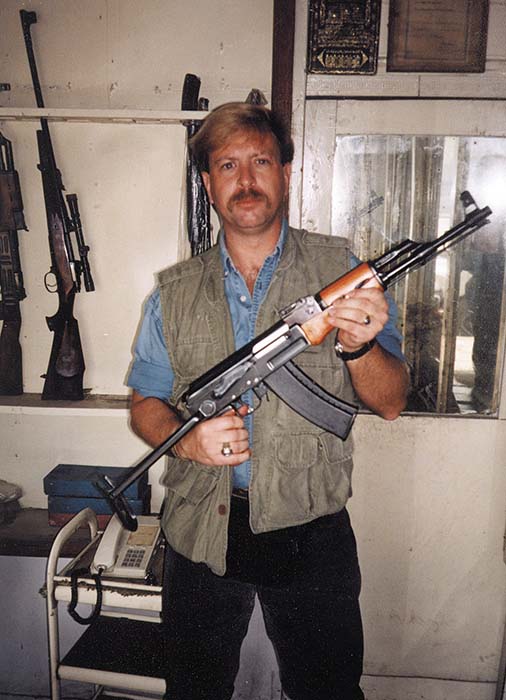
SAR Military Affairs Correspondent Rob Krott has traveled extensively for the TV show The World’s Most Dangerous Places which can be seen on the Travel Channel. He hasn’t shot anything, or anybody, with his Afghan jezail.
| This article first appeared in Small Arms Review V5N5 (February 2002) |











